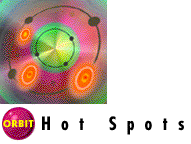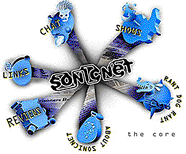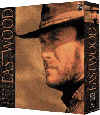



The Media Lab at the Massachusetts Institute of Technology is celebrating its tenth anniversary today (Oct. 10) after a week-long celebratory run-up.
A research center dedicated to developing cutting edge technologies that will shape our future, the Media Lab works on everything from holographic imaging to computer interfaces. According to the Media Lab's promotional material, "The not-so-hidden agenda is to drive technological inventions and break engineering deadlocks with new perspectives and demanding applications."

Scientist Henry Lieberman
"Our role is to make prototypes of new technologies, and show them what's possible." says Lieberman. In addition to the intelligent Web browser, Lieberman is attacking the age old viewing methods of zoom and pan. Focusing in on an object or moving from one object to another causes the wider context of a scene to be lost, leading to what Lieberman calls that "lost in hyperspace" feeling.
"We are exploring alternative solutions, such as a new technique which allows zooming and panning in multiple layers," says Lieberman.
The result of his work would solve the problem that he poses: "How would you browse a very large display space, such as a street map of the entire world?"

Dr. Matthew Brand

Professor Justine Cassell
Looking at the projects being worked on at the lab is like glimpsing into the future. Dr. Matthew Brand is working on a project to make computers understand how humans manipulate imaginary objects. Another colleague Professor Justine Cassell is working to integrate non-verbal signs, such as body language and intonation, into human figure animation. The system being developed could eventually enable computers to interpret and use intonation and animated body language.
Still another Assistant Professor Kenneth Haase is working on memory-based representation systems which would be able to search news articles for key words, and summarize the differences between similar articles.Haase is also working on a project similar to that of Professor Justine Cassell's. The project aims at teaching computers how to utilize all the cues used in human speech. The ultimate goal is "to generate speech which is easier to under stand, harder to misunderstand, and easier to listen to with partial attention," says Haase.

Professor Pattie Maes
Professor Maes is also trying to solve the ever-pressing problem of information overload, which is starting to affect a large segment of the population becomes inundated with immense loads of data.
"We are building interface agents that make personalized suggestions to a user for items the user may want to select such as news articles, videos, television shows, and other meia"
The Media Lab has over 100 ongoing projects. Aside from some of the sexier projects mentioned above, the Media Lab has a number of projects looking into the use of computers in schools. Project Headlight was started in 1984 in collaboration with IBM and the Hennigan School, a multicultural, public elementary school in Boston. The project became a testbed for early ideas about the use of computers in the context of an essentially traditional school. The Media Lab also has a project looking into learning in multicultural settings at the Paige Academy, a small independent Afrocentric school in the Roxbury section of Boston.
Another project in Boston communities is one that looks into the use of computer networks to support urban communities. The project is unique because it looks at connecting people who live next to each other rather than hundreds of miles away. Neighbors in an economically disadvantaged section of Boston use the system to organize a food cooperative, crime watch, and read online articles fromThe Boston Globe.
Professor Neil Gershenfeld, a resarcher at MIT says the Media Lab has had a great ten years and has an equally exciting decade ahead of it. "The first decade of the Media Lab helped disconnect bits from historical representations (such as digital video)," he says. The next decade will see much more work at the boundary between bits and atoms, looking at how to weave useful intelligence into our environment." Professor Neil Gershenfeld's research group is working to create devices for a new consortium called Thinks That Think. The consortium is sponsored by a wide range of organizations from Motorola to Nike and Disney. Gershenfeld said some of the things his group is devel oping include "shoes that can send data through a handshake and recover power from walking; and digital musical instruments that are as satisfying as traditional ones."
As would be expected, the Media Lab has an extensive presence on the Internet. Detailed information on all of the Lab's ongoing projects, and you can participate in the lab's 10th anniversary through a special web site.


Have a hot tip, comments or suggestions?
Please contact our editors at
Living Digital@prodigy.com
Copyright (c) 1995 Prodigy Services Company and/or respective information providers.



Any chance I get, I tell people about SonicNet. No, really. I've told two friends and then some. Launched as an alternative music BBS in June 1994 by entrepreneur Tim Nye and some of his friends, SonicNet managed to attract 10,000 users in their first year, despite their decidedly lo-tech terminal interface.
I raved to anyone who would listen about their commitment to new music and their skillful manipulation of their interactive medium. Any slaves to pop music in its indie form were all right in my books and Lou Barlow had an email address there. I could be nothing but their dedicated fan.
May came, and SonicNet brought yet another moment of joy to my existence in the form of a well designed beta web site, that was like no other music page I'd seen before. That first day, in all the excitement, I lost my Net connection by picking up the phone to tell two more friends.
SonicNet's New York based creative team weren't just cataloguing sound clips and photos, they were creating truly interactive content -- hypertext articles, bulletin boards and chats -- based on the culture and attitude of alternative music. Their approach seemed right at home within the larger culture of the Net.

Here was a site with high quality interactive content, cool imagery and great, easy to navigate design. As you'd expect, I considered my world rocked. I downloaded a Butterglory single from "Action Ready Singles" a selection of songs exclusive to SonicNet, poked around the < href="http://www.sonicnet.com/feature/loser/loser.html ">Losers Guide to New York City and bookmarked the sex tips and questionnaires on Red, Hot and Bothered, the indie rock guide to dating. Needless to say, I started telling strangers as well as friends.
Last week, SonicNet changed. A new and improved site was ready for the masses. They hosted a launch party to honor its new look at an art gallery in New York -- complete with balloons, hot dogs, Oreos and party favors, as well as gratuitous GWAR moments and free beer. I was allowed to talk about SonicNet ad nauseam.

The Sonic Core links you to hypertext record and video reviews, guides to live shows in major cities, an ambitious chat schedule including the 'simulchat' Mystery Melrose Theater , an interactive editorial/rant section and an eccentric guide to links beyond their own little smart alecky alternative music love-in.
SonicNet now features some great writers, with superstar rock journalist and author of Nirvana biography "Come as you Are" Michael Azerrad as music editor. (Among their stable of writers, I was happy to see one of my favorite rock curmudgeons, J.R. Taylor, a writer for NY Press, bring his cool and pleasantly baffling rock criticism to the net at large.)
But this ain't no static medium and users are encouraged to respond to articles and contribute their own recomendations and reviews. SonicNet will only get better once users break in the comfy interface by sharing their own indie-rock obsesed musings and rants.
You tell your friends and I'll tell mine.
(The opionions expressed herein are truly that of the writer, who was in no way influenced by the pork by-products and complimentary mousepad that SonicNet tried to woo her with. As if! She might, however, want to consult someone about her obsessive tendancies.)


Have a hot tip, comments or suggestions?
Please contact our editors at
Living Digital@prodigy.com
Copyright (c) 1995 Prodigy Services Company and/or respective information providers.



From hard-boiled cops to flinty-eyed gunslingers, actor/director Clint Eastwood has given American moviegoers some of film's most unforgettable characters and riveting moments. Now fans can relive those moments and meet the man behind the legend in "Eastwood," a new CD-ROM from Starwave.
An interactive exploration of his life and career, "Eastwood" contains over 200 video and audio clips from all 53 of Clint Eastwood's films -- including rare footage from his personal library. The CD also features exclusive interviews with Eastwood as he discusses his career, his co-stars, the roles that made him famous, and aspects of his personal life.
"Eastwood" opens in the lobby of a movie theater where the walls are adorned with posters reflecting the different genre of films in which Clint Eastwood has appeared or directed. These include cop movies like "Dirty Harry" and westerns such as "The Unforgiven." By selecting one of the posters users are transported to an area where the genre is profiled.
By clicking the Cops poster for example, the screen changes to the Film Focus area where each of Eastwood's 11 police-action movies are listed. Each movie is accompanied by a synopsis, cast and credit listing and film reviews. Sources for the latter include The New York Times, Los Angeles Times, and Time magazine, and renown critics like Roger Ebert.
Also included with each movie listing is commentary on that film by Clint Eastwood himself. In the section on the Academy Award winning "The Unforgiven" users can hear Eastwood's thoughts about the movie's theme and the violence depicted in it.
After users finish examining the various in Film Focus they can take a biographical look at Clint Eastwood's non-film life through an interactive timeline. The years 1930 (the time of his birth) to 1995 are profiled in the presentation. Many of the elements are "hot" which means clicking on them will reveal interview footage, home movie clips, music recordings, and clips from Clint Eastwood's early work in TV commercials.
At the end of the CD users can test their knowledge about Eastwood's life through a trivia game of 450 related questions. Images from the CD-ROM can also be used to customize desktop environments.
With "Eastwood" -- and the upcoming "All This Time," an interactive biography of pop musician Sting -- Starwave has taken the medium of CD-ROM publishing to a new level. No longer is multimedia confined to graphic intensive games or a mish-mash of unrelated pictures, sounds, and video. "Eastwood" shows that with care and the proper effort, a digital production can be more than the sum of its parts.
If you're a fan of Clint Eastwood this CD-ROM documentary will make your day.


Have a hot tip, comments or suggestions?
Please contact our editors at
Living Digital@prodigy.com
Copyright (c) 1995 Prodigy Services Company and/or respective information providers.